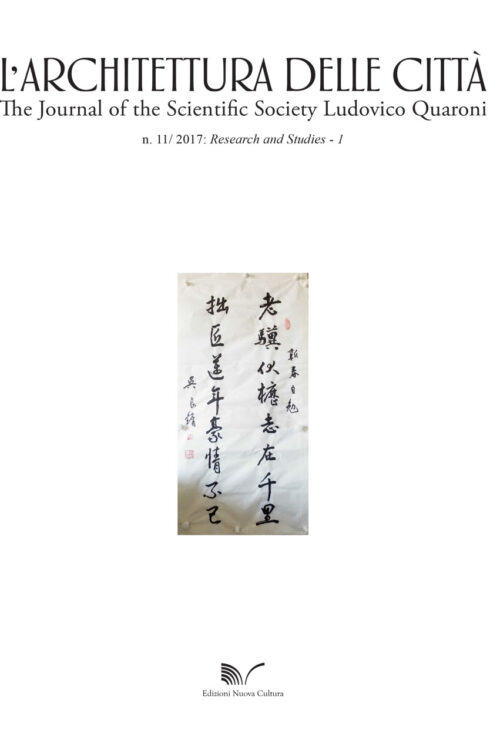
Rivista L’architettura delle città n. 3-4-5/2014: The City in the Evolutionary age
The Journal of the Scientific Society Ludovico Quaroni
€11.40 – €38.00
Prior to the Second World War Europe’s ruling classes had no perception of the destiny of the modern city. This despite the fact that almost a century earlier Baudelaire had intoned the decadence of their most beautiful city. Proud of their ordered, authoritative, and often authoritarian capitals, Europeans saw history as a course predestined to create that miracle of civilisation exemplified by the metropolis of the old continent: wealthy, with a rigid social hierarchy, symbolically, physically and culturally rooted in history, firmly established at the summit of a providential, though still highly dramatic process. The metropolises of Europe were perceived, in the end, as organisms at the pinnacle of their conscious maturity and the height of their industrial and financial might. They appeared to posses an ability to self-regulate internal and external conflicts, imposing models of assimilation and reciprocal adaptation upon sources of imbalances, conceived by imagining the possible effects of disturbances and anticipating their transformations – thus adopting planning in the form of a series of direct systematic operations.
Two years later, in 1939, Claude Lévi Strauss went much further; his direct experience with São Paulo, Brazil (and New York) convinced him that the modern metropolis, which he observed and which observed him with a thousand hidden eyes as he, a foreigner, crossed it, cannot be judged according to the parameters of architecture (thus also excluding those of planning), but with those of the landscape; and to the same degree that everything in the natural landscape is in transformation, simultaneously luxuriance and putrefaction, he claimed that «the cities of the New World […] pass from first youth to decrepitude with no intermediary stage». With no intermediate stage: this is the most important clue, the tag that for the great anthropologist implicitly, though peremptorily, invalidated the idea that the cities of the New World are truly part of history.
Lévi Strauss, who certainly learned to be a narrator of cultures and ethnographic contexts as Walter Benjamin learned to be a narrator of cities, froze – despite being captivated – in front of the metropolises of the New World, home to a coexistence between past and present, and between proximity and distance.
Perhaps the time has come to truly study the world’s metropolises as individuals in the midst – or at the beginning – of their evolutionary age seeking to establish their stage of development and that of their parts, in the concreteness of reality. The term stage is used here to refer to a recognisable and well-characterised structure that is organised and relatively balanced – equivalent to one of the stages of Jean Piaget’s theory of development. This would make it possible in the most appropriate terms to solicit different urban communities to autonomously imagine the effects of on-going disturbances, accompanying them as they realistically express their fears and desires and anticipate the form and objectives of tangible operations to be implemented within the limits of a community’s available resources and level of organisation and the pedagogic capacities of the city and its government.
Following the forewords essays expanding the theme of “evolutionary city”, this second volume of the review “L’architettura delle città – The Journal of the Scientific Society Ludovico Quaroni” includes a dense number of papers from the proceedings of the Seminar East-Africa Cities Lab. Urbanization vs Human Survival – organized by the UNESCO-Chair in “Sustainable Urban Quality and Urban Culture, notably in Africa” of Sapienza University of Rome and held in Rome on April 28th 2014 – and a number of papers submitted by international scholars for an “internal” call for paper among the partners institutions of the UNESCO-Chair on the theme: “the evolutionary age of the city”. The volume is divided in three sections distinguished for geographical areas and issues: East-Africa Cities, Hydro-Generated Urbanism in Latin America, China New Urbanization. Here after some bibliographical notes follow. They are supposed to be useful to integrate the studies related to the themes of the three sections of this volume and to the contributions collected.
L’ADC N-3-4-5
Foreword – The City in the Evolutionary Age
Lucio Valerio Barbera
Introduction – A brief annotated bibliography around the concept of “evolutionary city”.
East-Africa Cities; Hydro-Generated Urbanism in Latin America, China New Urbanization
Anna Irene Del Monaco
East-Africa Cities
Khartoum 2030 Towards An Environmentally-Sensitive Vision for the Development of Greater Khartoum, Sudan
Gamal M. Hamid, Ibrahim Z. Bahreldin
Landscapes of Desert Architecture and city around the Islamic Sahara
Filippo De Dominicis
‘Wandering Capitals’ and the Genesis of Addis Ababa
Benyam Muhe
For An Eritrean Culture, or a Culture of Resistance
Gentucca Canella
Asmara urban history and development
Belula Tecle-Misghina
Forced migratory flows in Eastern Africa A preliminary analysis of refugees’ reception in Ethiopia
Nica Claudia Calò, Enza Roberta Petrillo
Islamic Cultural Trends in East Africa
Adriana Piga
The importance of communitarian voluntary association in development cooperation: Kibera and Mathare slums in Nairobi
Giulia Murgia
Low-income groups and living environment in the cities of the Republic of Malawi. A direct survey about formal and informal settlements
Yasuhiro Hayashi
D’Urban Resilience – The Warwick Junction Precinct
Yashaen Luckan
“Hydro-Generated Urbanism” in Latin America
Creating Sustainable Urbanity in the Fringe The Periphery as an opportunity for future Centrality
Martha Kohen
Reconsidering the Tijuana River Canal: Three Scenarios for Action
Nancy M. Clark
An urban project for Costanera of Asunción
Claudio Gatta
L’ADC n.1-2 (eng)
Foreword: L’architettura delle città – The Journal of the Scientific Society Ludovico Quaroni
Lucio Valerio Barbera
Introduction: The First Issue of the Review “L’architettura delle città. The Journal of the Scientific Society Ludovico Quaroni”
Anna Irene Del Monaco
The competition project for the New Passenger Terminal at Termini Rail Station(1947-’48)
Lucio Valerio Barbera
Parish Church of Santa Maria Maggiore in Francavilla al Mare (1948). The Search for a Measure
Ettore Vadini
Church of the Holy Family in Genoa (1956-’59)
Antonino Terranova
A School in Rosignano Solvay (1961-’63)
Mario Guido Cusmano, Rossella Rossi
A place called “Il Gualdo” (1965)
Roberto Maestro
Ludovico Quaroni and his project of a “Garden village” in Apulia (1973)
Antonio Riondino
Ludovico Quaroni and the Anagnina residential district (1985)
Ludovico Micara, Vieri Quilici
The ‘Quartiere game’
Vieri Quilici
Emergence-urban fabric in the urban design of Ludovico Quaroni: morphology vs typology
L’ADC n.1-2 (ita)
Presentazione: L’architettura delle città-The Journal of the Scientific Society Ludovico Quaroni
Lucio Valerio Barbera
Introduzione – Il primo numero della rivista L’architettura delle città. The Journal of the Scientific Society Ludovico Quaroni
Anna Irene Del Monaco
Esercizi di trascrizione di opere contemporanee di architettura italiana
Il progetto di concorso per il Nuovo fabbricato viaggiatori della Stazione Termini, Roma (1947-’48)
Lucio Valerio Barbera
Chiesa parrocchiale di Santa Maria Maggiore a Francavilla al Mare (1948) La ricerca di una misura
Ettore Vadini
Chiesa della Sacra Famiglia a Genova (1956-’59)
Antonino Terranova
Una Scuola a Rosignano Solvay (1961-’63)
Mario Guido Cusmano, Rossella Rossi
Un luogo chiamato “Il Gualdo” (1965) Relazione sul progetto del Gualdo a Punta Ala
Roberto Maestro
Ludovico Quaroni e il progetto di “borgo Giardino” in Puglia (1973) Territorio / paesaggio / città: la forma urbana come procedimento interscalare
Antonio Riondino
Il quartiere Anagnina di Ludovico Quaroni (1985)
Ludovico Micara, Vieri Quilici
Il Gioco del quartiere. Quando la didattica si misura con la realtà
Vieri Quilici
Emergenza-tessuto nei progetti urbani di Ludovico Quaroni: morfologia vs tipologia (1936-’65)
Anna Irene Del Monaco
The Scientific Society Ludovico Quaroni was founded in Rome in 2010 as a tribute to Ludovico Quaroni, the Italian Master of Urban Architecture. Its purpose is “the study of the contemporary and historical city and architecture; the study of the design and theoretical works of the leading architects and scholars of architecture, the city and the territory”. To achieve these goals, the Scientific Society Ludovico Quaroni has founded the present electronic review, “L’architettura delle città – The Journal of the Scientific Society Ludovico Quaroni”. The title is a reminder of Ludovico Quaroni’s earliest book entitled L’architettura delle città (Ed. Sansaini, Rome 1939).
Anno: 2015
Pagine: 312
Formato: 24 x 17 cm
Peso Kg: 0.468
Colore: Quadricromia
Copertina: Morbida
Legatura: Brossura
Lingua: Inglese
ISBN cartaceo: 9788868123550
ISBN digitale: 9788868124601





